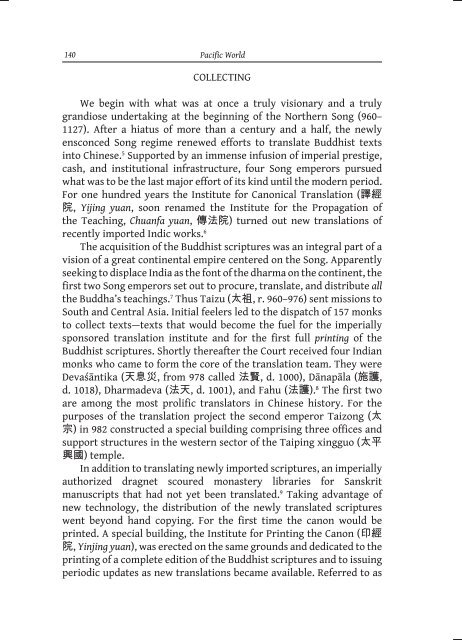Looking for Bhairava - The Institute of Buddhist Studies
Looking for Bhairava - The Institute of Buddhist Studies
Looking for Bhairava - The Institute of Buddhist Studies
- No tags were found...
You also want an ePaper? Increase the reach of your titles
YUMPU automatically turns print PDFs into web optimized ePapers that Google loves.
140Pacific WorldCollectingWe begin with what was at once a truly visionary and a trulygrandiose undertaking at the beginning <strong>of</strong> the Northern Song (960–1127). After a hiatus <strong>of</strong> more than a century and a half, the newlyensconced Song regime renewed ef<strong>for</strong>ts to translate <strong>Buddhist</strong> textsinto Chinese. 5 Supported by an immense infusion <strong>of</strong> imperial prestige,cash, and institutional infrastructure, four Song emperors pursuedwhat was to be the last major ef<strong>for</strong>t <strong>of</strong> its kind until the modern period.For one hundred years the <strong>Institute</strong> <strong>for</strong> Canonical Translation ( 譯 經院 , Yijing yuan, soon renamed the <strong>Institute</strong> <strong>for</strong> the Propagation <strong>of</strong>the Teaching, Chuanfa yuan, 傳 法 院 ) turned out new translations <strong>of</strong>recently imported Indic works. 6<strong>The</strong> acquisition <strong>of</strong> the <strong>Buddhist</strong> scriptures was an integral part <strong>of</strong> avision <strong>of</strong> a great continental empire centered on the Song. Apparentlyseeking to displace India as the font <strong>of</strong> the dharma on the continent, thefirst two Song emperors set out to procure, translate, and distribute allthe Buddha’s teachings. 7 Thus Taizu ( 太 祖 , r. 960–976) sent missions toSouth and Central Asia. Initial feelers led to the dispatch <strong>of</strong> 157 monksto collect texts—texts that would become the fuel <strong>for</strong> the imperiallysponsored translation institute and <strong>for</strong> the first full printing <strong>of</strong> the<strong>Buddhist</strong> scriptures. Shortly thereafter the Court received four Indianmonks who came to <strong>for</strong>m the core <strong>of</strong> the translation team. <strong>The</strong>y wereDevaśāntika ( 天 息 災 , from 978 called 法 賢 , d. 1000), Dānapāla ( 施 護 ,d. 1018), Dharmadeva ( 法 天 , d. 1001), and Fahu ( 法 護 ). 8 <strong>The</strong> first twoare among the most prolific translators in Chinese history. For thepurposes <strong>of</strong> the translation project the second emperor Taizong ( 太宗 ) in 982 constructed a special building comprising three <strong>of</strong>fices andsupport structures in the western sector <strong>of</strong> the Taiping xingguo ( 太 平興 國 ) temple.In addition to translating newly imported scriptures, an imperiallyauthorized dragnet scoured monastery libraries <strong>for</strong> Sanskritmanuscripts that had not yet been translated. 9 Taking advantage <strong>of</strong>new technology, the distribution <strong>of</strong> the newly translated scriptureswent beyond hand copying. For the first time the canon would beprinted. A special building, the <strong>Institute</strong> <strong>for</strong> Printing the Canon ( 印 經院 , Yinjing yuan), was erected on the same grounds and dedicated to theprinting <strong>of</strong> a complete edition <strong>of</strong> the <strong>Buddhist</strong> scriptures and to issuingperiodic updates as new translations became available. Referred to as
















